
An ironclad is a steam-propelled warship protected by steel or iron armor constructed from 1859 to the early 1890s. The ironclad was developed as a result of the vulnerability of wooden warships to explosive or incendiary shells. The first ironclad battleship, Gloire, was launched by the French Navy in November 1859, narrowly preempting the British Royal Navy. However, Britain built the first completely iron-hulled warships.

The seventh HMS Enterprise of the Royal Navy was an armoured sloop launched in 1864 at Deptford Dockyard. Originally laid down as a wooden screw sloop of the Camelion class, she was redesigned by Edward Reed and completed as a central battery ironclad. The ship spent the bulk of her career assigned to the Mediterranean Fleet before returning to England in 1871 where she was paid off. Enterprise was sold for scrap in 1885.

HMS Triumph, originally known as Libertad, was the second of the two Swiftsure-class pre-dreadnought battleships of the Royal Navy. The ship was ordered by the Chilean Navy, but she was purchased by the United Kingdom as part of ending the Argentine–Chilean naval arms race. Triumph was initially assigned to the Home Fleet and Channel Fleets before being transferred to the Mediterranean Fleet in 1909. The ship briefly rejoined the Home Fleet in 1912 before she was transferred abroad to the China Station in 1913. Triumph participated in the hunt for the German East Asia Squadron of Maximilian Graf von Spee and in the campaign against the German colony at Qingdao, China early in World War I. The ship was transferred to the Mediterranean in early 1915 to participate in the Dardanelles Campaign against the Ottoman Empire. She was torpedoed and sunk off Gaba Tepe by the German submarine U-21 on 25 May 1915.

The Warrior-class ironclads were a class of two warships built for the Royal Navy between 1859 and 1862, the first ocean-going ironclads with iron hulls ever constructed. The ships were designed as armoured frigates in response to an invasion scare sparked by the launch of the French ironclad Gloire and her three sisters in 1858. They were initially armed with a mix of rifled breech-loading and muzzle-loading smoothbore guns, but the Armstrong breech-loading guns proved unreliable and were ultimately withdrawn from service.

HMS Venerable (1899) was a member of the London class of pre-dreadnought battleships built for the British Royal Navy. The Londons were near repeats of the preceding Formidable-class battleships, but with modified armour protection. Venerable's main battery consisted of four 12-inch (305-mm) guns, and she had top speed of 18 knots. The ship was laid down in January 1899, was launched in November that year, and was completed in November 1902. Commissioned that month, Venerable served in the Mediterranean Fleet until 1908, and was subsequently recommissioned into the Channel Fleet. Following a major refit in 1909, she served with the Atlantic and Home Fleets.

HMS Resolution was a Royal Sovereign-class pre-dreadnought battleship of the Royal Navy. The ship was built by Palmers Shipbuilding and Iron Company, starting with her keel laying in June 1890. She was launched in May 1892 and, after completing trials, was commissioned into the Channel Squadron the following December. She was armed with a main battery of four 13.5-inch guns and a secondary battery of ten 6-inch guns. The ship had a top speed of 16.5 knots.
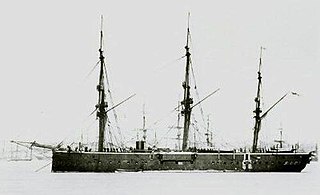
HMS Audacious was the lead ship of the Audacious-class ironclads built for the Royal Navy in the late 1860s. They were designed as second-class ironclads suitable for use on foreign stations and the ship spent the bulk of her career on the China Station. She was decommissioned in 1894 and hulked in 1902 for use as a training ship. The ship was towed to Scapa Flow after the beginning of the First World War to be used as a receiving ship and then to Rosyth after the war ended. Audacious was sold for scrap in 1929.
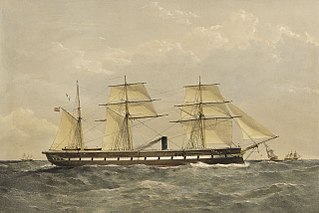
HMS Resistance was the second of two Defence-class ironclads built for the Royal Navy in the 1860s. She was the first capital ship in the Royal Navy to be fitted with a ram and was given the nickname of Old Rammo. Resistance was initially assigned to the Channel Fleet upon commissioning, but was transferred to the Mediterranean Fleet in 1864, the first ironclad to be assigned to that fleet. She was rearmed in 1867 and became a guardship when recommissioned in 1869. The ship was reassigned to the Channel Fleet in 1873 before reverting to her former duties in 1877. Resistance was decommissioned in 1880 and was used for gunnery and torpedo trials beginning in 1885. The ship was sold for scrap in 1898 and foundered in 1899 en route to the breaker's yard. She was salvaged and later scrapped.

The Defence-class ironclads were a class of two warships built for the Royal Navy between 1859 and 1862. The ships were designed as armoured frigates in response to an invasion scare sparked by the launch of the French ironclad Gloire and her three sisters in 1858. They were initially armed with a mix of rifled breech-loading and muzzle-loading smoothbore guns, but the Armstrong breech-loading guns proved unreliable and were withdrawn from service after a few years.
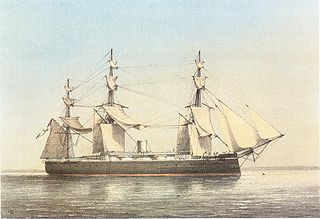
HMS Monarch was the first seagoing British warship to carry her guns in turrets, and the first British warship to carry guns of 12-inch (300 mm) calibre.

HMS Sultan was a broadside ironclad of the Royal Navy of the Victorian era, who carried her main armament in a central box battery. She was named for Sultan Abdulaziz of the Ottoman Empire, who was visiting England when she was laid down. Abdulaziz cultivated good relations with the Second French Empire and the British. In 1867 he was the first Ottoman sultan to visit Western Europe; his trip included a visit to England, where he was made a Knight of the Garter by Queen Victoria and shown a Royal Navy Fleet Review, with Isma'il Pasha of Egypt.
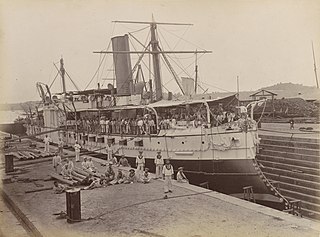
HMS Orion was a Belleisle-class ironclad of the Victorian Royal Navy. Originally constructed for the Ottoman Empire, and called Bourdjou-Zaffer, she was purchased by the British Government before completion.

HMS Collingwood was the lead ship of her class of ironclad battleships built for the Royal Navy during the 1880s. The ship's essential design became the standard for most of the following British battleships. Completed in 1887, she spent the next two years in reserve before she was assigned to the Mediterranean Fleet for the next eight years. After returning home in 1897, the ship spent the next six years as a guardship in Ireland. Collingwood was not significantly damaged during an accidental collision in 1899 and was paid off four years later. The ship was sold for scrap in 1909 and subsequently broken up.
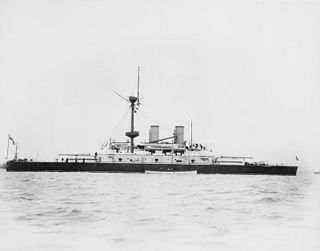
HMS Howe was an Admiral-class ironclad battleship built for the Royal Navy during the 1880s. The ship was assigned to the Channel Fleet in mid-1890 and was badly damaged when she ran aground in late 1892. After repairs were completed, Howe was transferred to the Mediterranean Fleet in late 1893. She returned home in late 1896 and became a guardship in Ireland. Howe remained there until late 1901 when she was assigned to the Reserve Fleet. The ship was paid off in three years later and then sold for scrap in 1910.

HMS Anson was the last of six Admiral-class ironclad battleships built for the Royal Navy during the 1880s. The ship was completed, except for her armament, in 1887, but had to wait two years for her guns to be installed. She was assigned to the Channel Fleet in mid-1889 as a flagship for the fleet's second-in-command. Two years later, the passenger ship SS Utopia sank with the loss of 562 lives after colliding with Anson in the Bay of Gibraltar. In mid-1893, Anson was transferred to the Mediterranean Fleet, subsequently returning home in 1900 when she was assigned to the Reserve Fleet. She recommissioned for the Home Fleet in early 1901. Anson was paid off three years later and then sold for scrap in 1909.
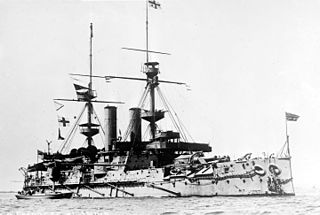
HMS Empress of India was one of seven Royal Sovereign-class pre-dreadnought battleships built for the Royal Navy during the 1890s. The ship was commissioned in 1893 and served as the flagship of the second-in-command of the Channel Fleet for two years. She was transferred to the Mediterranean Fleet in 1897, during which time Empress of India was assigned to the International Squadron blockading Crete during the uprising there. She returned home in 1901 and was briefly assigned as a coast guard ship in Ireland before she became the second flagship of the Home Fleet. The ship was reduced to reserve in 1905 and accidentally collided with the submarine HMS A10 the following year. Empress of India was taken out of service in early 1912 and accidentally struck a German sailing ship while under tow. She was sunk as a target ship in 1913.

HMS Ramillies was a Royal Sovereign-class pre-dreadnought battleship of the Royal Navy, named after the Battle of Ramillies. The ship was built by J. & G. Thompson at Clydebank, starting with her keel laying in August 1890. She was launched in March 1892 and commissioned into the Mediterranean Fleet as flagship the following October. She was armed with a main battery of four 13.5-inch guns and a secondary battery of ten 6-inch guns. The ship had a top speed of 16.5 knots.

HMS Barfleur was the second and last of the Centurion-class pre-dreadnought battleships built for the Royal Navy in the 1890s. Intended for service abroad, they exchanged heavy armour and a powerful armament for high speed and long range to counter the foreign armoured cruisers then being built as commerce raiders and were rated as second-class battleships.

HMS Rapid was an 11-gun Rosario-class wooden-hulled screw-driven sloop of the Royal Navy, launched on 29 November 1860 at Deptford Dockyard and broken up in 1881.

HMS Myrmidon was a Cormorant-class gunvessel of the Royal Navy, built at Chatham Dockyard and launched in 1867. She served on the North America and West Indies Station and surveyed parts of the Australian coast before being sold at Hong Kong in 1889.























